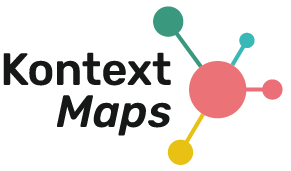Interview with Jlona Caduff
Hello Jlona, you have been a KontextMaps user for years. Why?
They are unique! Only with the Maps we can make extensive amounts of information accessible in a clear and yet in the required depth and breadth. This helps the user to find their way around even in complex legal topics. KontextMaps uses the digital possibilities of a contemporary, interactive and visual information transfer. And using it is also fun!
And what exactly do you do?
I was a “classical” lawyer and in-house counsel for 20 years before founding Legal by Design AG in 2019. Our core activity is Legal Information Design, i.e. the human- and user-centered preparation and communication of legal topics. We support our customers in the selection, organization, structuring, presentation and communication of legal content so that it can be quickly and easily found, read, understood and implemented by the addressees. Of course, this also applies to digital formats. We also use KontextMaps for this purpose.
You have already made a name for yourself with it in the meantime!
Exactly. We call them “LegalMaps”. These are visual and interactive “knowledge maps” for all important topics such as data protection, house searches, purchasing topics, contract law, finances and compliance. My customers are mostly legal and compliance departments of Swiss, and sometimes also internationally active, companies from a wide range of industries. What they all have in common is that they have a large amount of information that is quite fragmented and they face the challenge of getting it to people in a structured, clear and digestible form. LegalMaps are ideal for this and word has obviously got around in my field.
You have been using KontextMaps since you started working as a legal information designer. How did you find us and why do you use them in so many of your projects?
In my old job, I was aware of the problems and tried a few things, but I kept coming up against a point where I didn’t know what else to do. I knew from my network that many other lawyers and compliance officers had faced the same challenges and had struggled with them. That’s when I decided to tackle the solution to the most pressing problems with Legal by Design AG:
- We produce far too much information, which we bombard our addressees with. Due to digital possibilities, the dynamics of business, but also the legal environment and ever tighter regulation, the amount of information will continue to increase.
- Our information is usually so scattered and confusing that even finding the relevant content is laborious in itself. The time and energy invested in this is a waste of valuable resources – which ultimately also costs a lot of money. Information that is not found cannot reach its intended audience. And if too much time and energy is needed to find and understand it, people give up.
- We demotivate and overwhelm our addressees with our traditional, legal “walls of text”. Today, no one has the time or inclination to work their way through dozens of documents with hundreds of pages from top to bottom.
- We, as legal professionals, know too much and often assume that our audience has too much prior knowledge and wrongly assume that they can categorize our information and put it in the right context. We regularly forget to show them the big picture. Or just as problematic: we inform them about topics that are interesting for us, but completely irrelevant to them.
- Information is now provided in digital form. But instead of using the appropriate options for this, we provide lists of PDFs and post them on the intranet. We still think and work in print.
And the bottom line?
My most important realization over the years: We rely far too much on our addressees “learning” our content. That is, that they are read and then internalized. “Reality Check: That’s not how it is!” I did a lot of research on instructional/learning design and invested in solutions until I realized: it is absolutely impossible for our audience to store our information in their long-term memory, keep it there, and remember it when needed. And luckily, it doesn’t need to be that way!
We have to get away from this illusion and find a solution that offers quick and easy access to the relevant content. When you need it, what you need and how you need it.
My conclusion is therefore that all the approaches using training slides, e-learning or webinars are unsuitable for effectively conveying information and skills. Instead, we have to rely on the other cognitive processes such as perception, attention and, above all, the information processing that is relevant at the respective moment of questioning and drawing conclusions.
So you’re going to take a completely different approach?
Our question is actually different: What can we do to ensure that our information is found and perceived when it is needed? How can we avoid demotivation, offer the addressee a step-by-step approach to the topics that corresponds to their individual needs and previous knowledge – moving away from the “push” principle and towards the “pull” principle? So that our content is not only perceived, but also actually “consumed” or processed? How can we prepare this vast amount of information in such a way that cognitive overload is avoided? And what does good usability mean in the context of digital information?
We can discard the idea of traditional websites. We have far too much material and content. The result would be an incredibly complicated information architecture with hundreds of pages and jumps. It would be impossible to create a navigation that still offers the user the necessary orientation and overview.
I racked my brains over this for months, looking for ideas and approaches. For smaller topics, there are various great approaches that we use. But for more comprehensive topics with a lot of content in different formats, there are hardly any sensible solutions. It’s the same for every other knowledge worker – it’s not limited to the legal profession.
I still remember very well when I came across your technology one day and immediately realized: This is it! The technology that offers me all the basic functionalities I need to solve all these problems. I still remember it well and was so excited that I hardly slept for two nights .
Hopefully you’ve had a chance to catch up on that in the meantime. What do you think are the most important functionalities that make ContextMaps so exciting for you?
There are many! And there is a lot more in your pipeline. But the three main points are as follows:
- An incredible amount of content in a wide variety of formats and media can be processed in the mappings without any jumps. This means that no matter what you look at, you stay on the same page and don’t lose the big picture. Our LegalMaps usually have between 80 and 100 “bubbles”, with content (i.e. text, graphics, overviews and application examples) of about 1 page per bubble.
- The second important point is that users can be guided through a topic step by step, keyword “progressive disclosure”, thus avoiding demotivation and excessive demands. None of the users would guess how much content is actually in a LegalMap – it just feels different.
- And the third point concerns the quick and easy classification of questions and content. The maps allow visual and structured access to the topics. By this I don’t mean colorful pictures and illustrations, but a visually recognizable entry point into a question, logic, hierarchies, sequences and connections between the respective content.
What are the biggest challenges in your map projects?
The LegalMap approach actually convinces everyone we show examples to. We usually don’t have to explain much, the purpose and benefits of it all are obvious, and the technology is so inspiring that further map ideas often come before the project even starts – it’s highly addictive… but so are the benefits.
But the approach, the idea and the technology are one thing. Finding a suitable, user-centered and modular structure; deciding what is in and what is out of scope; preparing the content based on the respective concept. All of this requires a great deal of brainpower, creativity and intensive work. After all, it is also important to take into account the different needs and previous knowledge of the users in terms of content and to offer the maximum information value. For a user-centered approach and a needs-based access to our topics, we often have to deviate from our “legal thinking” or legal concepts. In the end, everything looks so logical and simple, but there is much more to it than you would expect.
And what do you enjoy most about your LegalMap projects?
How quickly the change in thinking and perspective away from legal concepts and structures to the needs of the addressees takes place. Suddenly, questions of usability, relevance, language, prioritization of information or frequent questions and search strategies of the recipients of legal information become self-evident topics of discussion. To be honest, I would never have thought that possible. And the best thing about it is that this mindset will remain and will have a lasting influence on the way we prepare and communicate legal information.
How have you found working with us in these first four years or so?
You are quite simply the best thing that could have happened to me and our customers. Apart from your globally unique technical solution, it is a huge advantage that I can rely on you. You take suggestions for improvement and criticism on board directly. With the other major software providers, I could forget about including my needs and those of my customers in development planning. And I have the luxury of having a direct line to you, which I can use to communicate with you almost day and night. And I experience it every day that you don’t just have a job, you all live for what you do.
Thanks for the flowers!
What do your customers say?
They love it! Once they understand that LegalMaps makes legal information easier and faster to access, it’s immediately clear that it saves time and, of course, money. On the one hand, in the legal and compliance departments themselves, but many times over for the addressees as well. And let’s not forget the reduction of risks, which is ultimately what it’s all about.
And where will your journey take you with KontextMaps?
Fortunately, our collaboration will continue for a long time to come, given all the ideas currently swirling around in my head and in those of my customers. Due to the positive experiences with a community project on data protection, I would like to continue this community approach next year in addition to the individual maps. Currently, a LegalMap for contractual topics is on sale, as well as a compliance globe with topics such as anti-corruption, antitrust law, money laundering, etc. But we are small, flexible and always open to good ideas.

